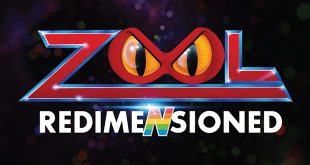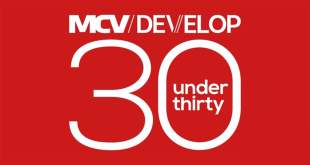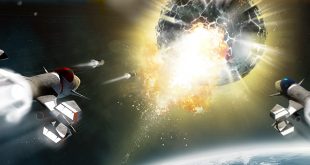Toby Draper, producer on Warhammer 40,000: Boltgun, tells Space Marine Vince Pavey about Auroch Digital’s intense retro shooter before the pair go on another perilous mission across the galaxy.
For just about as long as we’ve had video games, people have wanted to go on the power-trip of shooting at bad guys, and as technology has gotten better, the first-person genre has only grown and mutated along with the appetites of those playing as designers experiment and iterate. While John Carmack, John Romero, and Tom Hall popularised the 3D Shooter with the fantastic Wolfenstein 3D and it’s even more superb follow up Doom, it’s through this process of evolution (for lack of a better term) that despite still being loads of fun, the best-selling shooters at the moment can often feel like they have very little in common with their own predecessors.
Over here at MCV/DEVELOP, we’re thankful that much like the return of vinyl record collections and (ahem) niche video game magazines, there has in recent years been somewhat of a nostalgic resurgence of what is now often called the ‘boomer’ flavour of first-person shooter, in an attempt to scratch that specific sort of itch. Boltgun is one of those games, with labyrinthian levels, keys and secrets to collect, more guns than a person could feasibly carry at once, and hordes of foes to blast them with on your path to glory. What makes it stand apart from the rest of the revival shooter crowd, however, is that it’s also a licensed game.
A popular IP like Warhammer 40K getting into the indie shooter space was pretty much unprecedented when it was first announced, and strangely feels unlikely to be repeated, as much as we’d like to see something like Aliens, Jurassic Park or The Punisher make the same move. Boltgun seems like such an anomaly in fact, that it makes us curious as to how the pitch to the brand owners at Games Workshop came about, and whether the manufacturer of miniature wargames was immediately on board.
“We have a lot of huge Warhammer fans at the studio and two of them, Aaron Ashbrooke (creative director) and Sam Chester (principle programmer), came up with the idea for Boltgun,” explains Toby Draper, a producer on Boltgun. “Aaron pitched the game and Games Workshop liked it. Then they took it to Focus, who decided they wanted to fund and publish the title.
“Games Workshop saw the potential in the pitch and liked the idea. I was not involved in the pitch, but I worked closely with Games Workshop and the rest of the dev team, to help get every single asset approved and signed off. I can’t make the call to say that they were immediately on board, I don’t think they needed much convincing.”

FROM DUSK TILL DAWN OF WAR
With its key cards and maze-like levels, Boltgun quite obviously stands on the shoulders of giants, and wears its influences on its sleeves – although some of those giants were released more recently than you might think.
“We were mostly inspired by timeless classics from the ‘boomer’ shooter genre like Quake and Doom, as well as more recent but retro shooters like Dusk, and Ion Fury,” explains Draper. “The retro style meant we leaned into games from the 90’s when searching for inspiration, although it has to be said, we also spent a lot of time playing and researching Warhammer 40K and its many games.”
It is no surprise then, that when it came to design, one of the first things to get right was making sure that the player character and his experiences really felt like they were part of the expanded Warhammer universe, right there alongside those other games.
“We took extreme care when designing weapons, enemies, levels and even the player character to ensure that we were up to the Games Workshop’s standards, and to ensure that we were strictly correct to the 40K lore.
“The blood and gore was also super important to us. We wanted it to be dynamic, exciting and fun, so a lot of hours went into making sure it was good. Another important thing to consider was the ‘feel’ of the space marine player character – things like the character’s weight, movement and abilities.”
While generally regarded as a ‘retro’ shooter by the average gamer, Boltgun also incorporates a lot of elements of modern shooter design to smooth out some of the rougher edges of the retro experience. It’s actually not dissimilar to other indie modern classics like Shovel Knight or Bloodstained: Curse of the Moon in that way. Warhammer 40K: Boltgun feels like one of those nostalgic shooters, without ever feeling needlessly restrained by the design and technical limitations of nearly 30 years ago, and that’s by design.
“We went for a retro aesthetic with a modern feel – we felt like it should look like you’re in the 1990’s, but feel like you’re playing in the 2020’s,” explains Draper. “A lot of retro shooters have quite restrictive movement, so you can only turn 90 degrees at a time. They also have a pretty basic weapon pool, mainly due to the tools available to the developers at the time.
“Boltgun takes advantage of the fact it’s made in Unreal Engine 4, with modern physics, exciting weapons and clever design. We made the combat responsive and dynamic, to try and create as much fun as possible for players. A lot of classic retro shooters might not have had such dynamic systems in place, or include such elaborate weapons.”
Doom, Quake and Duke all had fairly genre defining multiplayer at one point another, so it was only right that a multiplayer versus mode was at least thought about for their Warhammer 40K shooter, despite it ultimately not making it into the final release. “We considered including player-vs-player multiplayer, but quickly realised that development would definitely not have been the same as the one we experienced,” muses Draper, diplomatically. “We never had any plans for co-op.”

PIXEL MINIATURES
The pixel art in Boltgun was made by artists using actual miniatures for reference material, providing the look and feel of both the creatures and enemy combatants the player encounters with an air of authenticity that reinforces that Boltgun took place in Games Workshop’s incomperable universe. “All of the enemies, weapons and environments in 40K Boltgun are all based on real 40K miniatures. You can buy most of the pieces in Games Workshop stores now, with the exception of Malum Caedo, our main character. If you want to get your hands on a physical version of him, you’ll have to kitbash!” says Draper, cheekily.
“Essentially, Games Workshop sent us over a bunch of physical models, and our art team sat at their desks with the models in front of them and created 3D, high-poly renders of the miniatures. We then applied a layer of ‘pixelization’ to them, which created the sprites that you see in game. “As we reached the end of our process, we then had to export all the sprites for approvals with Games Workshop.”
While Draper wouldn’t make many (if any) changes to Boltgun as a game, the way Boltgun was developed itself changed as it was worked on, to adjust for the project’s scope and changes at the studio in a variety of different ways. “The production process on Boltgun was fluid, evolving and adapting to the project’s needs,” he explains. “When we began, this was the biggest project the studio had taken on, and the production methodologies we used were probably more suitable for smaller projects.
“As both the Auroch team and the Boltgun team grew, we began to learn new ways of working and applied a few new production techniques to our existing systems. By the end of the project, it felt like we had a really solid production pipeline and the build and test loop was strong. Figuring out the pipeline, and how the build/test loop was going to work, took time. If we had to start again, I’d say the only thing I’d want to change would be to implement the same production pipeline that we had by the end of the project, at the start of the project.”
It’s been a few months since its launch, and Boltgun has been embraced by the wider Warhammer fandom and gamers alike. “In general, the reaction to Boltgun has been amazing,” explains Draper. “The team has been absolutely blown away with the response. We’ve had wonderful reviews on Steam, and our Metacritic score is good and seems to be slowly rising. Not to mention, all the incredible fan art and photos from players making models of Malum Caedo!
“There is the occasional bad review, or comment, but generally those are outliers and not to be taken to heart. A lot of the negative things people had to say were things that we’d done intentionally, either to be truthful to the lore or to stop something else from totally breaking. Knowing that makes it much easier to take on the chin.”
When it comes to what’s next for Boltgun, beyond the immediate post-launch plan, Draper is tight-lipped. That’s not because the game underperformed, or that there’s a lack of desire to create a sequel, but simply because it’s a little too soon to announce anything – and in any case, the studio is busy enough with other things.
“We’ve just released a quality of life patch in the last couple of weeks,” says Draper. “After that, there are no plans to continue work on Boltgun at this time. Other conversations have happened behind the scenes, but nothing is set in stone as of yet. Be sure to follow Auroch Digital’s social channels, as those will be the first place we share any exciting announcements!”

 MCV/DEVELOP News, events, research and jobs from the games industry
MCV/DEVELOP News, events, research and jobs from the games industry




